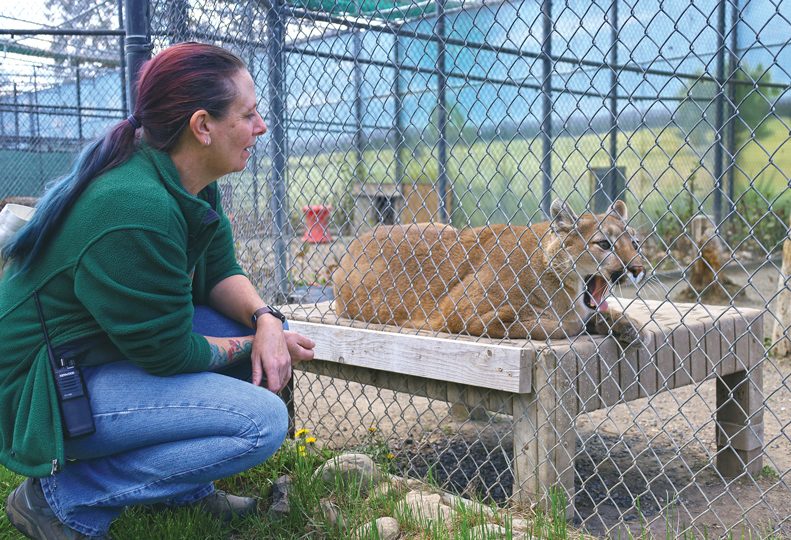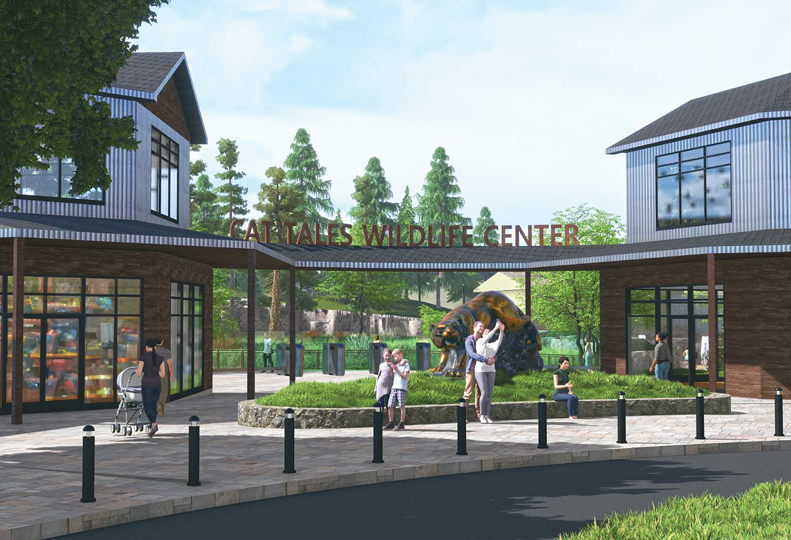
Home » Big hopes for big cats: Cat Tales envisions relocation
Big hopes for big cats: Cat Tales envisions relocation
Wildlife rescue organization eyes property five times larger than its current facility in north Spokane County

Cat Tales executive director Lisa Grey greets 6-year-old mountain lion, Kachina, at the feline's enclosure.
| Erica BullockMay 9, 2024
Cat Tales Wildlife Center, a zoological park and wildlife rescue nonprofit in Mead, has unveiled a conceptual relocation master plan for a proposed new conservation campus in Spokane County.
If developed as envisioned, the park would be on a site in north Spokane County that's five times the size of the current complex, with a price tag of about $146 million.
A future relocation is only in the planning stage now, says Lisa Grey, executive director at Cat Tales.
To bring the envisioned plans to life, the nonprofit wildlife center will need to address funding to move from its current 4-acre property, located at 17020 N. Newport Highway, in Mead, says Grey.
"Since this master plan is in the millions, it's not something that we'll earn in our annual budget," says Grey. "Someone asked me if it's just a pipe dream, and I say it's up to the community. It's either going to have to be city bond funded with people willing to vote and pass it, or we get private investors. Another suggestion was to approach the tribes."
The conceptual relocation master plan was created for Cat Tales by Deer Park native Megan Clermont, a zoological designer, who developed the proposal as part of her senior capstone project while earning a graduate certificate in landscape architecture from UCLA.
 Rendering by Megan Clermont
Rendering by Megan ClermontVisitors could be welcomed by a new entrance plaza at the proposed new wildlife center for Cat Tales in north Spokane County.
The plan identifies a site about 2 miles west of Cat Tales for the proposed relocation of the wildlife center, at 1404 E. Riverview Drive.
The property features 20 acres of land on a basalt plateau where five distinct habitats could be developed to showcase wildlife from the Cascades, Okanogan, Columbia Plateau, Blue Mountains, and Rocky Mountain regions.
Animal exhibits in the proposal include a total of 2 acres for large and small felines, 0.5 acres each for canines, bears, and hooved animals, 5,000 total square feet of aquatic animal exhibits for both beavers and river otters, and a 5,000-square-foot aviary.
Additionally, the conceptual plan includes animal management amenities such as a 1,000-square-foot clinic and a 1,600-square-foot animal food storage facility.
Facility operations at the envisioned new site include administration and education buildings, maintenance and equipment storage, an equine processing facility, groundskeeper's residence, and garden spaces.
Proposed guest areas include a drop-off zone, bus, recreational vehicle, and general parking, an entry plaza, a playground and splash pad area, an amphitheater, and a 5,000-square-foot lodge for events, classes, and food service.
Currently, the majority of the wildlife center property is dedicated to enclosed animal habitats, in addition to an office and gift shop building, a picnic shelter, a yard for summer camp classes, and a few residential structures for 24/7 supervision of the animals.
"I have railroad tracks behind us, so I can't grow east. I have a highway here that's growing towards us, so I can't grow west. We have 18 animals and you can't give them multilevels because it's not safe. I have businesses and residences at either end and no one wants to walk a super long walk back to their car," explains Grey.
Cat Tales provides care and a permanent home for rescued, nonreleasable exotic animals, as well as wildlife native to the Central and Eastern Washington. Animals at the wildlife center include black bears, bobcats, Canadian Lynx, coyotes, foxes, mountain lions, racoons, servals, Bengal and Siberian tigers, and wolfdogs.
Cat Tales is an acronym for Care About Them, Tell About the Lord’s Endangered Species, according to the organization’s website.
At a fundraising gala for Cat Tales in April at the Garland Theater, Grey introduced the conceptual master relocation plan to about 100 guests in attendance.
"We released our master relocation plan at the Garland ... because, selfishly, I wanted to see that on the big screen," she says laughing, adding that the nonprofit broke even on the event.
"It was worth it for the experience and exposure," Grey says.
While Cat Tales considers funding options for a new home, the organization also is working on accreditation from two entities, the Zoological Association of America and the American Camp Association, Grey says.
Cat Tales has been operating without a need for accreditation from those two entities since opening in 1991, but many shipping companies, such as FedEx, have new policies in place that require animal centers to earn accreditation in order to send or receive animals at their facilities.
Cat Tales also will continue operating its Wildlife Academy, which is a professional zookeeper training program and vocational school licensed by the Washington Workforce Training and Education board.
About 250 graduates have completed workforce training at the academy in the 25 years the school has been open. Students have gone on to work in a variety of careers as well as for notable programs around the world, says Grey.
The academy program is a year long to give students experience caring for wildlife in each season.
"You're going to work 12-hour days, whether it's 100 degrees or negative 10 degrees," she says. "But for students who stick with it, we have keepers in Australia, and one of our graduates even worked for Siegfried and Roy."
Cat Tales has three full-time employees including Grey; her husband Randy Grey, operations and maintenance manager; and her stepmother Debbie Wyche, who co-founded Cat Tales with Grey's late father Mike Wyche.
Five to 10 volunteers also help run the facility, depending on the season, plus five current academy students. Additionally, five interns are expected from Washington State University this summer, where they will get hands-on experience needed for veterinary school.
Overall, Grey says, she'd be happy to see the community rally to support a new legacy facility, but she's realistic enough to understand that the cost is significant to bring the vision for a new sanctuary to life.
Grey asks Spokane-area residents to consider supporting the nonprofit's relocation plans by contributing to a funding solution for a proposed new home.
“We have to go somewhere else if we’re going to grow and give them more," says Grey.
Latest News Instagram
Related Articles
Related Products




![Brad head shot[1] web](https://www.spokanejournal.com/ext/resources/2025/03/10/thumb/Brad-Head-Shot[1]_web.jpg?1741642753)
